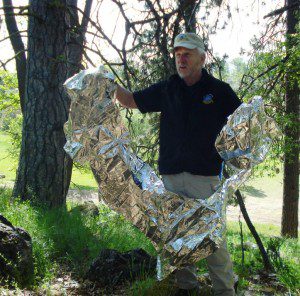A few thoughts on taking care of your compass and what to look for before you go hiking in the backcountry.
Remember that the correct operation of the compass is dependent on the action of the magnetic needle to guide the hunter through the backcountry. Lots of items in a pack and clothing can affect the needle. Most understand that ferrous objects such as a rifle barrel, belt buckle, and car keys will deflect the magnetic needle. Still, take a good look at what is in a day pack. The batteries from the GPS receiver and a flash light may cause a compass needle to move.
High tension power lines and a vehicle’s electrical system may also cause a magnetic needle to deflect. Moving a few steps from the vehicle should be sufficient. One may have to move over one hundred feet from the power lines to avoid deflection. (GPS Made Easy, Michael Ferguson.)
Some locations will have a high concentration of iron near the surface. This is known as “local attraction.” Such concentrations will cause the needle to move too. Unlike declination, moving away from the immediate area may cause the deflection to stop. The local Bureau of Land Management or Forest Service Office should be able to identify areas affected by local attraction.
Recently, a retired forester commented that he had left his GPS and compass left on the dashboard of his truck. The lanyard that came with the compass was wrapped tightly around both the GPS receiver and compass. He estimated that the two sat on the dashboard for a little over three months. He later noticed that the compass was roughly 30° off. It’s an interesting anecdote that does bring up the point of how a compass must be properly stored.
I recommend that a compass be stored away from electronics (e.g., GPS, radios), batteries and many metallic (knives, saw) objects found in a pack. I don’t recommend going overboard on this but a compass could simply go in an exterior compartment, a shirt or coat pocket. Attaching a brake away lanyard to a compass so that is worn around the next is a viable option. This would apply during the off season too; a little separation is a good thing.

It is possible for the magnetic needle to lose its polarity. This is a function of time and manufacture. With research, one can learn how to restore the magnetism. That said, with the modern liquid filled compass this is probably more trouble than it is worth. Occasionally, check the alignment of the compass. In the small town where I live, residential streets are aligned true north and south. Standing on the curb on such a street provides a quick verification of how the compass is working. To me verification means that the compass direction will mirror that of the street; if the street tracks true north then the adjusted compass should provide a bearing to true north.
At the end of the hiking or hunting season take a look at the compass. Flush away dirt or sand that may be on the baseplate or sighting mirror. Look for bubbles that may appear internally and adjacent to the compass needle. A small bubble may not be something to worry about but a large bubble may impact how the needle swings and moves. A compass with a large bubble should be permanently removed from the hiker’s kit.
Lastly, keep in mind that a quality compass will retail for $20 or more. Also, a quality compass can be mechanically adjusted for declination. Such a compass is a precision piece of equipment. This is especially true of the Silva Ranger style or the Brunton Eclipse models. Note that I am prejudice (won’t buy them) towards the cheap stuff found on the racks of the major box sporting goods stores. If a hunter is willing to spend hundreds of dollars on a rifle scope why not spend a bit more for a decent compass; it can make a huge difference.












